Business Leadership B329: Child Poverty and Exclusion Report Analysis
VerifiedAdded on 2022/12/26
|9
|2565
|58
Report
AI Summary
This report provides a comprehensive analysis of a leadership challenge focused on child poverty and exclusion, specifically addressing the work of the organization Family for Every Child. The report begins with an introduction to leadership and its impact on achieving organizational goals, followed by a reflection on the chosen leadership challenge: issues surrounding child poverty and exclusion. The author details the reasons for selecting this challenge, linking it to leadership theories such as those relevant to multicultural environments and boundaryless leadership. The report then outlines the development of a call to action, focusing on resistance leadership and its application within Family for Every Child. It describes the call to action, the responses received, and suggestions for improvement. The evaluation section examines resistance leadership as a chosen approach, its strengths, and weaknesses, and how it applies to the organization. The analysis includes a discussion of how other leadership concepts could complement or address the weaknesses of resistance leadership. The report concludes that while resistance leadership has both positive and negative aspects, the weaknesses outweigh the strengths, primarily because it focuses heavily on leader behavior rather than organizational impact.
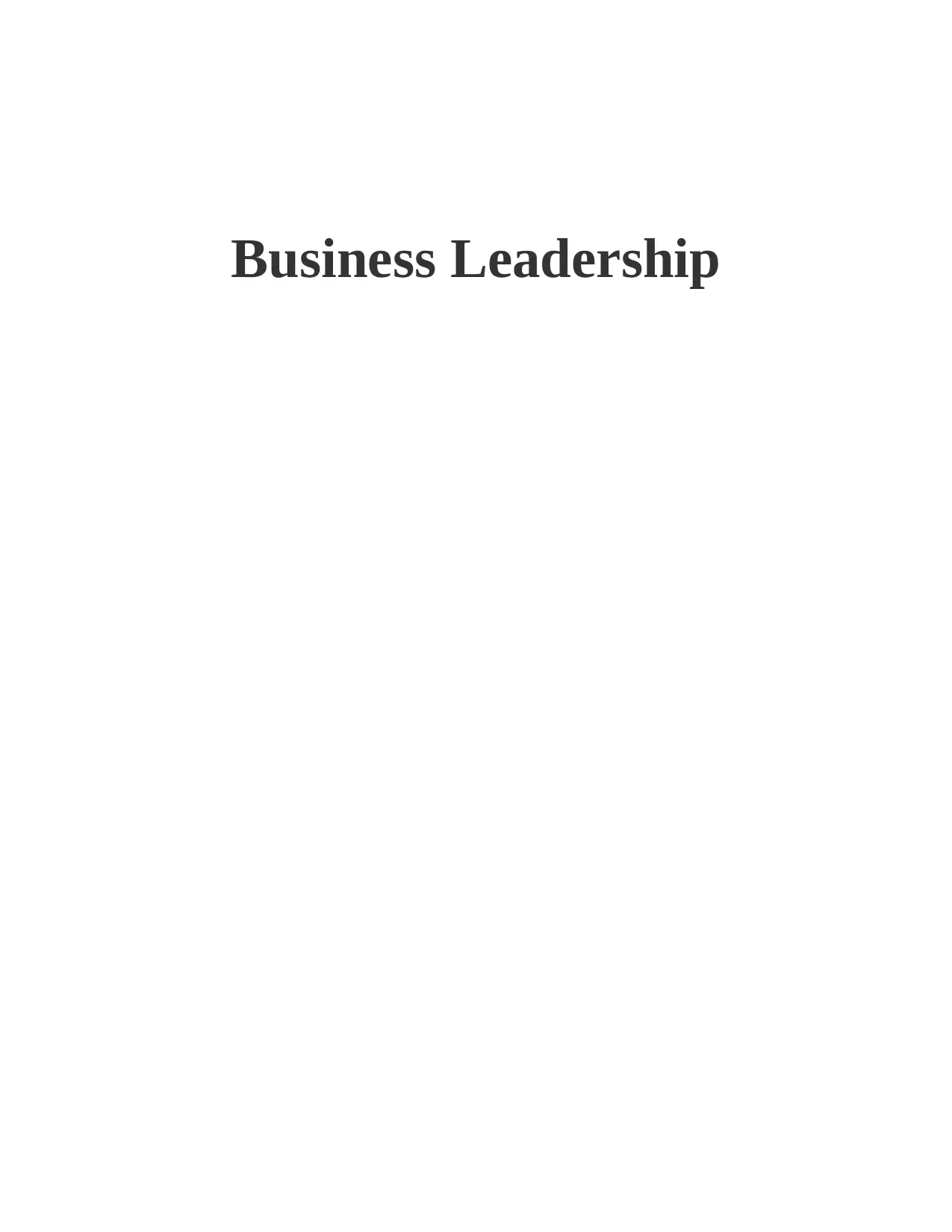
Business Leadership
Secure Best Marks with AI Grader
Need help grading? Try our AI Grader for instant feedback on your assignments.
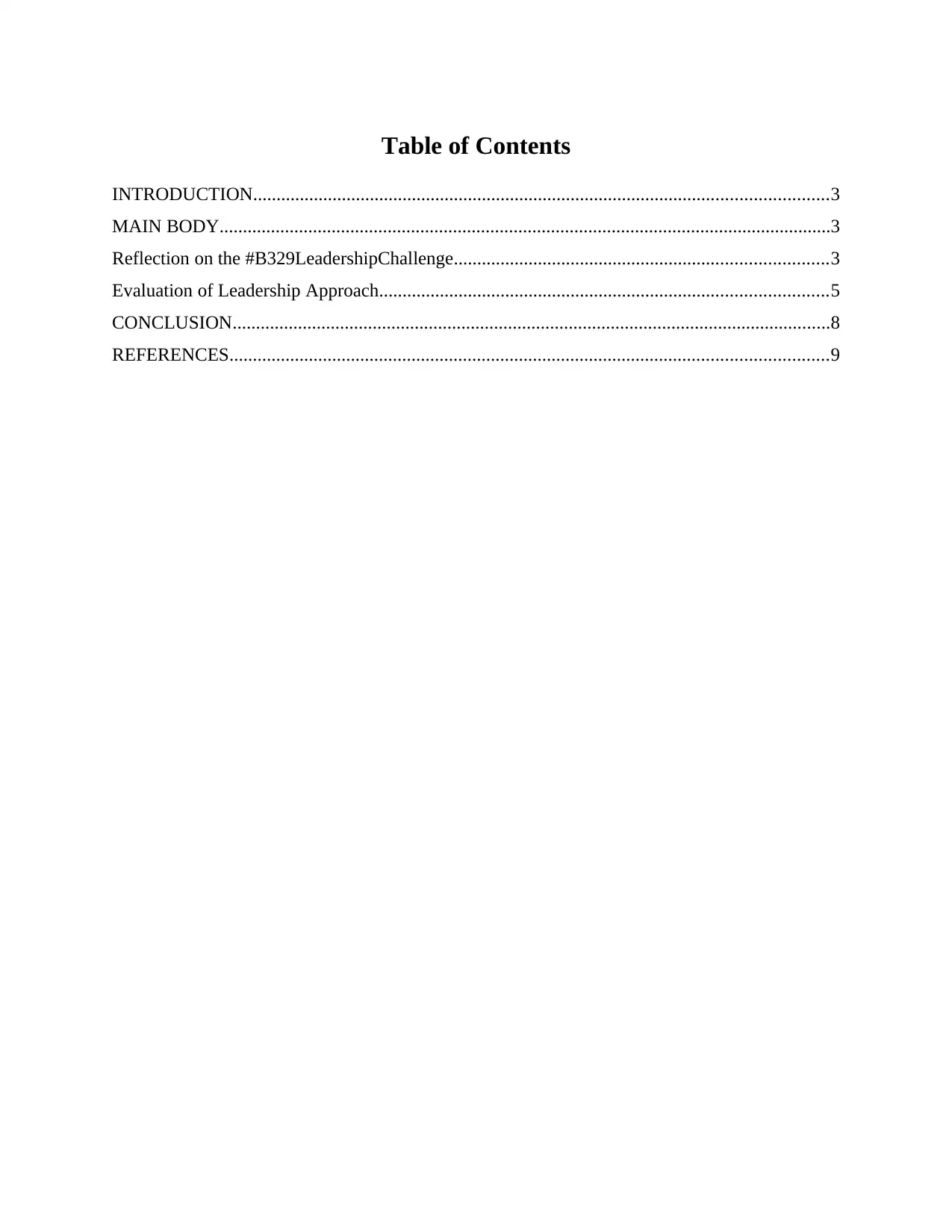
Table of Contents
INTRODUCTION...........................................................................................................................3
MAIN BODY...................................................................................................................................3
Reflection on the #B329LeadershipChallenge................................................................................3
Evaluation of Leadership Approach................................................................................................5
CONCLUSION................................................................................................................................8
REFERENCES................................................................................................................................9
INTRODUCTION...........................................................................................................................3
MAIN BODY...................................................................................................................................3
Reflection on the #B329LeadershipChallenge................................................................................3
Evaluation of Leadership Approach................................................................................................5
CONCLUSION................................................................................................................................8
REFERENCES................................................................................................................................9
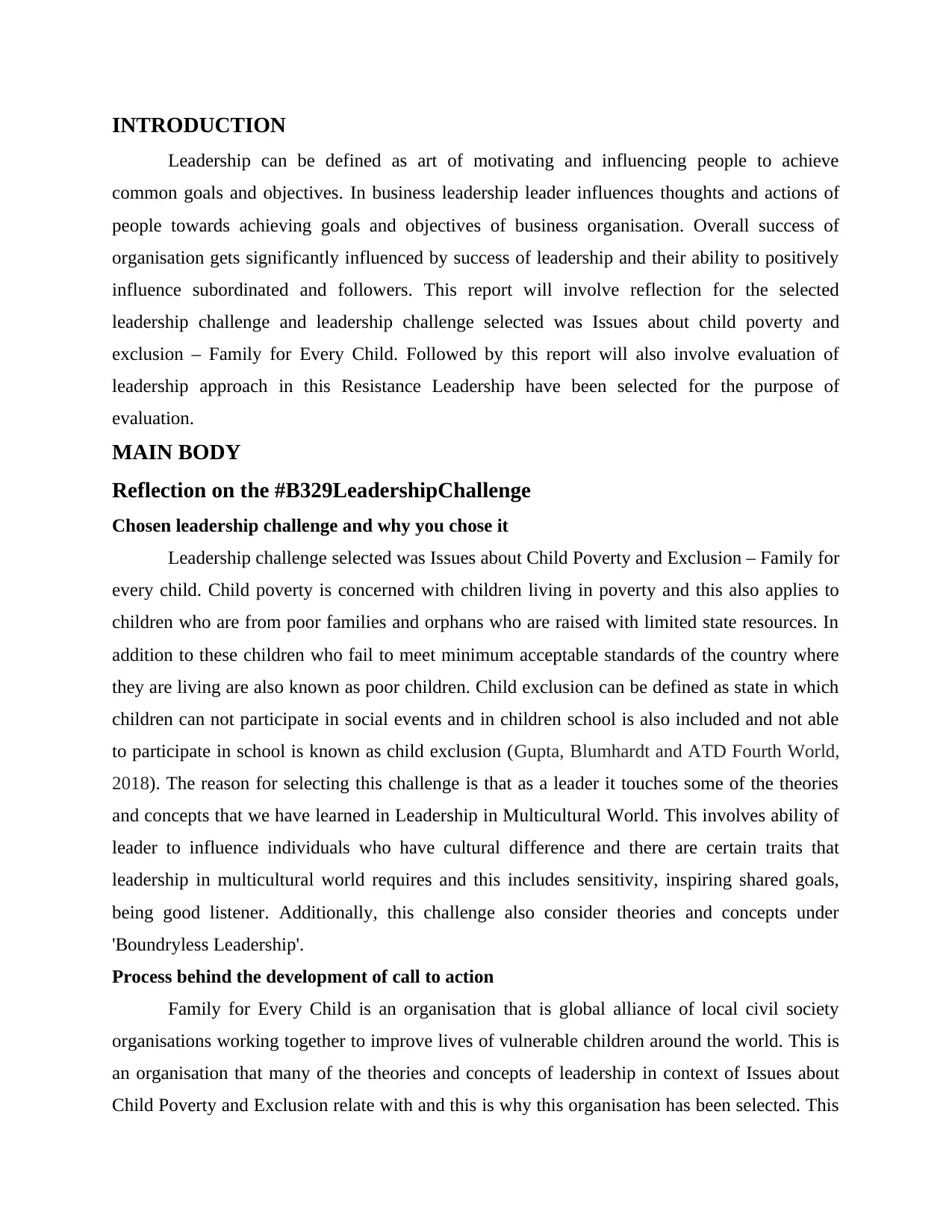
INTRODUCTION
Leadership can be defined as art of motivating and influencing people to achieve
common goals and objectives. In business leadership leader influences thoughts and actions of
people towards achieving goals and objectives of business organisation. Overall success of
organisation gets significantly influenced by success of leadership and their ability to positively
influence subordinated and followers. This report will involve reflection for the selected
leadership challenge and leadership challenge selected was Issues about child poverty and
exclusion – Family for Every Child. Followed by this report will also involve evaluation of
leadership approach in this Resistance Leadership have been selected for the purpose of
evaluation.
MAIN BODY
Reflection on the #B329LeadershipChallenge
Chosen leadership challenge and why you chose it
Leadership challenge selected was Issues about Child Poverty and Exclusion – Family for
every child. Child poverty is concerned with children living in poverty and this also applies to
children who are from poor families and orphans who are raised with limited state resources. In
addition to these children who fail to meet minimum acceptable standards of the country where
they are living are also known as poor children. Child exclusion can be defined as state in which
children can not participate in social events and in children school is also included and not able
to participate in school is known as child exclusion (Gupta, Blumhardt and ATD Fourth World,
2018). The reason for selecting this challenge is that as a leader it touches some of the theories
and concepts that we have learned in Leadership in Multicultural World. This involves ability of
leader to influence individuals who have cultural difference and there are certain traits that
leadership in multicultural world requires and this includes sensitivity, inspiring shared goals,
being good listener. Additionally, this challenge also consider theories and concepts under
'Boundryless Leadership'.
Process behind the development of call to action
Family for Every Child is an organisation that is global alliance of local civil society
organisations working together to improve lives of vulnerable children around the world. This is
an organisation that many of the theories and concepts of leadership in context of Issues about
Child Poverty and Exclusion relate with and this is why this organisation has been selected. This
Leadership can be defined as art of motivating and influencing people to achieve
common goals and objectives. In business leadership leader influences thoughts and actions of
people towards achieving goals and objectives of business organisation. Overall success of
organisation gets significantly influenced by success of leadership and their ability to positively
influence subordinated and followers. This report will involve reflection for the selected
leadership challenge and leadership challenge selected was Issues about child poverty and
exclusion – Family for Every Child. Followed by this report will also involve evaluation of
leadership approach in this Resistance Leadership have been selected for the purpose of
evaluation.
MAIN BODY
Reflection on the #B329LeadershipChallenge
Chosen leadership challenge and why you chose it
Leadership challenge selected was Issues about Child Poverty and Exclusion – Family for
every child. Child poverty is concerned with children living in poverty and this also applies to
children who are from poor families and orphans who are raised with limited state resources. In
addition to these children who fail to meet minimum acceptable standards of the country where
they are living are also known as poor children. Child exclusion can be defined as state in which
children can not participate in social events and in children school is also included and not able
to participate in school is known as child exclusion (Gupta, Blumhardt and ATD Fourth World,
2018). The reason for selecting this challenge is that as a leader it touches some of the theories
and concepts that we have learned in Leadership in Multicultural World. This involves ability of
leader to influence individuals who have cultural difference and there are certain traits that
leadership in multicultural world requires and this includes sensitivity, inspiring shared goals,
being good listener. Additionally, this challenge also consider theories and concepts under
'Boundryless Leadership'.
Process behind the development of call to action
Family for Every Child is an organisation that is global alliance of local civil society
organisations working together to improve lives of vulnerable children around the world. This is
an organisation that many of the theories and concepts of leadership in context of Issues about
Child Poverty and Exclusion relate with and this is why this organisation has been selected. This
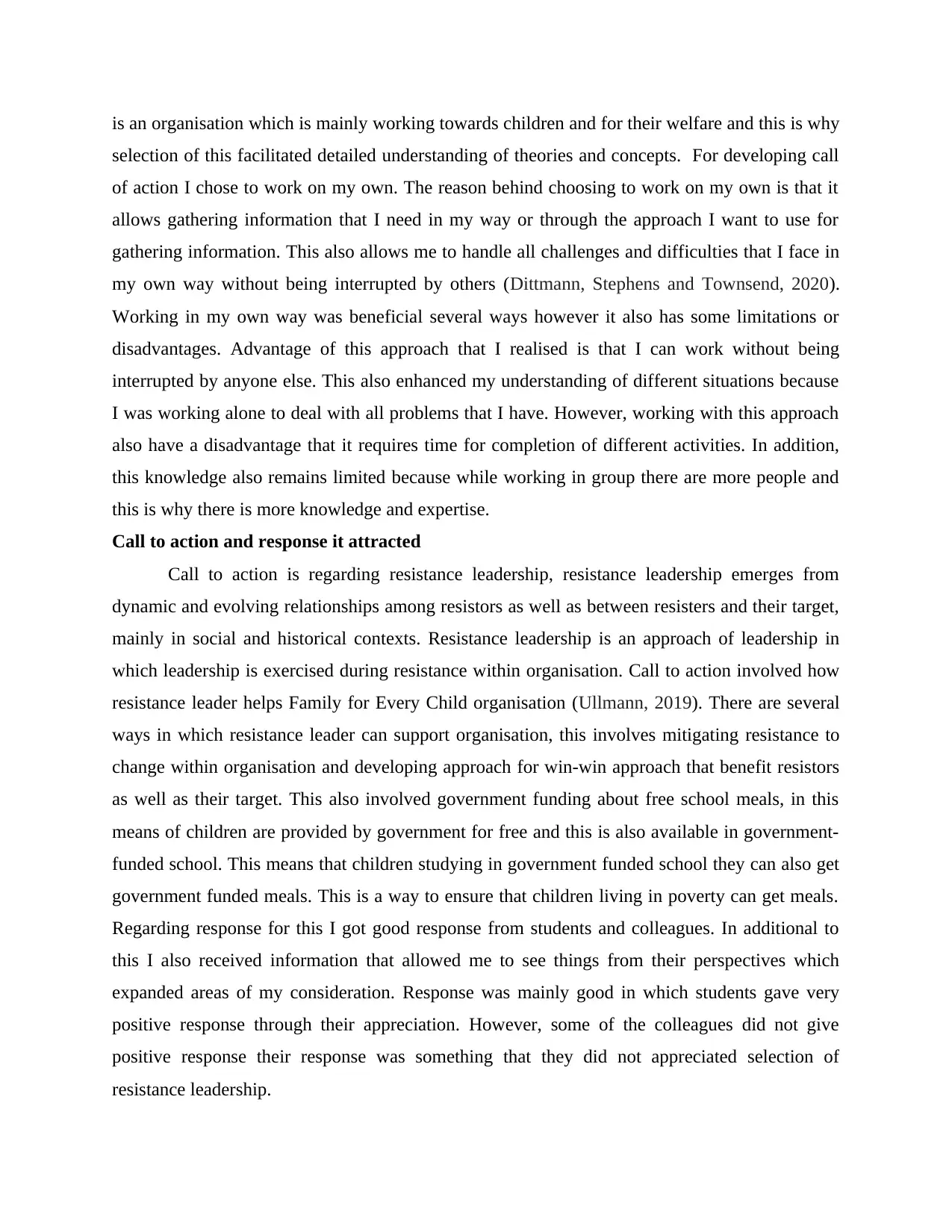
is an organisation which is mainly working towards children and for their welfare and this is why
selection of this facilitated detailed understanding of theories and concepts. For developing call
of action I chose to work on my own. The reason behind choosing to work on my own is that it
allows gathering information that I need in my way or through the approach I want to use for
gathering information. This also allows me to handle all challenges and difficulties that I face in
my own way without being interrupted by others (Dittmann, Stephens and Townsend, 2020).
Working in my own way was beneficial several ways however it also has some limitations or
disadvantages. Advantage of this approach that I realised is that I can work without being
interrupted by anyone else. This also enhanced my understanding of different situations because
I was working alone to deal with all problems that I have. However, working with this approach
also have a disadvantage that it requires time for completion of different activities. In addition,
this knowledge also remains limited because while working in group there are more people and
this is why there is more knowledge and expertise.
Call to action and response it attracted
Call to action is regarding resistance leadership, resistance leadership emerges from
dynamic and evolving relationships among resistors as well as between resisters and their target,
mainly in social and historical contexts. Resistance leadership is an approach of leadership in
which leadership is exercised during resistance within organisation. Call to action involved how
resistance leader helps Family for Every Child organisation (Ullmann, 2019). There are several
ways in which resistance leader can support organisation, this involves mitigating resistance to
change within organisation and developing approach for win-win approach that benefit resistors
as well as their target. This also involved government funding about free school meals, in this
means of children are provided by government for free and this is also available in government-
funded school. This means that children studying in government funded school they can also get
government funded meals. This is a way to ensure that children living in poverty can get meals.
Regarding response for this I got good response from students and colleagues. In additional to
this I also received information that allowed me to see things from their perspectives which
expanded areas of my consideration. Response was mainly good in which students gave very
positive response through their appreciation. However, some of the colleagues did not give
positive response their response was something that they did not appreciated selection of
resistance leadership.
selection of this facilitated detailed understanding of theories and concepts. For developing call
of action I chose to work on my own. The reason behind choosing to work on my own is that it
allows gathering information that I need in my way or through the approach I want to use for
gathering information. This also allows me to handle all challenges and difficulties that I face in
my own way without being interrupted by others (Dittmann, Stephens and Townsend, 2020).
Working in my own way was beneficial several ways however it also has some limitations or
disadvantages. Advantage of this approach that I realised is that I can work without being
interrupted by anyone else. This also enhanced my understanding of different situations because
I was working alone to deal with all problems that I have. However, working with this approach
also have a disadvantage that it requires time for completion of different activities. In addition,
this knowledge also remains limited because while working in group there are more people and
this is why there is more knowledge and expertise.
Call to action and response it attracted
Call to action is regarding resistance leadership, resistance leadership emerges from
dynamic and evolving relationships among resistors as well as between resisters and their target,
mainly in social and historical contexts. Resistance leadership is an approach of leadership in
which leadership is exercised during resistance within organisation. Call to action involved how
resistance leader helps Family for Every Child organisation (Ullmann, 2019). There are several
ways in which resistance leader can support organisation, this involves mitigating resistance to
change within organisation and developing approach for win-win approach that benefit resistors
as well as their target. This also involved government funding about free school meals, in this
means of children are provided by government for free and this is also available in government-
funded school. This means that children studying in government funded school they can also get
government funded meals. This is a way to ensure that children living in poverty can get meals.
Regarding response for this I got good response from students and colleagues. In additional to
this I also received information that allowed me to see things from their perspectives which
expanded areas of my consideration. Response was mainly good in which students gave very
positive response through their appreciation. However, some of the colleagues did not give
positive response their response was something that they did not appreciated selection of
resistance leadership.
Secure Best Marks with AI Grader
Need help grading? Try our AI Grader for instant feedback on your assignments.
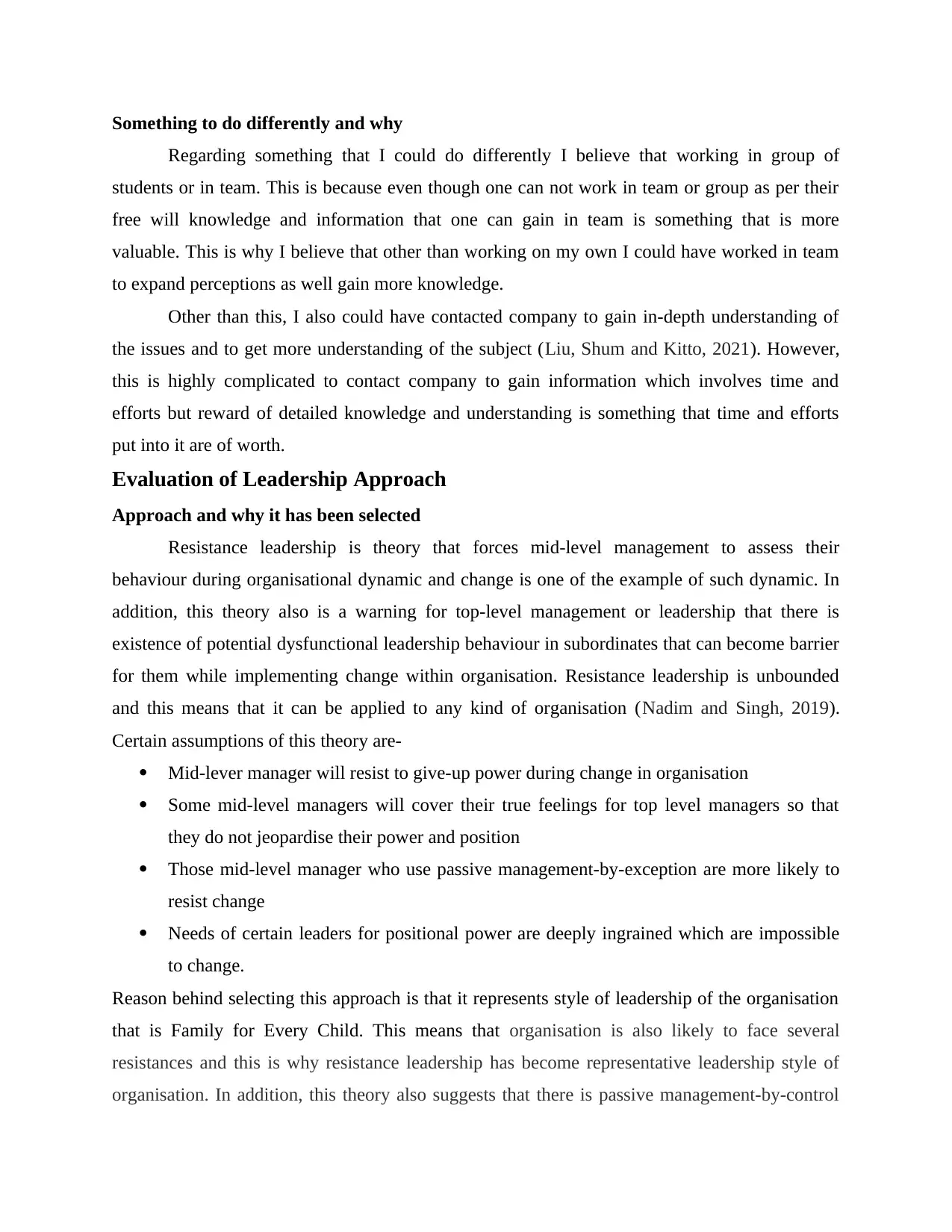
Something to do differently and why
Regarding something that I could do differently I believe that working in group of
students or in team. This is because even though one can not work in team or group as per their
free will knowledge and information that one can gain in team is something that is more
valuable. This is why I believe that other than working on my own I could have worked in team
to expand perceptions as well gain more knowledge.
Other than this, I also could have contacted company to gain in-depth understanding of
the issues and to get more understanding of the subject (Liu, Shum and Kitto, 2021). However,
this is highly complicated to contact company to gain information which involves time and
efforts but reward of detailed knowledge and understanding is something that time and efforts
put into it are of worth.
Evaluation of Leadership Approach
Approach and why it has been selected
Resistance leadership is theory that forces mid-level management to assess their
behaviour during organisational dynamic and change is one of the example of such dynamic. In
addition, this theory also is a warning for top-level management or leadership that there is
existence of potential dysfunctional leadership behaviour in subordinates that can become barrier
for them while implementing change within organisation. Resistance leadership is unbounded
and this means that it can be applied to any kind of organisation (Nadim and Singh, 2019).
Certain assumptions of this theory are-
Mid-lever manager will resist to give-up power during change in organisation
Some mid-level managers will cover their true feelings for top level managers so that
they do not jeopardise their power and position
Those mid-level manager who use passive management-by-exception are more likely to
resist change
Needs of certain leaders for positional power are deeply ingrained which are impossible
to change.
Reason behind selecting this approach is that it represents style of leadership of the organisation
that is Family for Every Child. This means that organisation is also likely to face several
resistances and this is why resistance leadership has become representative leadership style of
organisation. In addition, this theory also suggests that there is passive management-by-control
Regarding something that I could do differently I believe that working in group of
students or in team. This is because even though one can not work in team or group as per their
free will knowledge and information that one can gain in team is something that is more
valuable. This is why I believe that other than working on my own I could have worked in team
to expand perceptions as well gain more knowledge.
Other than this, I also could have contacted company to gain in-depth understanding of
the issues and to get more understanding of the subject (Liu, Shum and Kitto, 2021). However,
this is highly complicated to contact company to gain information which involves time and
efforts but reward of detailed knowledge and understanding is something that time and efforts
put into it are of worth.
Evaluation of Leadership Approach
Approach and why it has been selected
Resistance leadership is theory that forces mid-level management to assess their
behaviour during organisational dynamic and change is one of the example of such dynamic. In
addition, this theory also is a warning for top-level management or leadership that there is
existence of potential dysfunctional leadership behaviour in subordinates that can become barrier
for them while implementing change within organisation. Resistance leadership is unbounded
and this means that it can be applied to any kind of organisation (Nadim and Singh, 2019).
Certain assumptions of this theory are-
Mid-lever manager will resist to give-up power during change in organisation
Some mid-level managers will cover their true feelings for top level managers so that
they do not jeopardise their power and position
Those mid-level manager who use passive management-by-exception are more likely to
resist change
Needs of certain leaders for positional power are deeply ingrained which are impossible
to change.
Reason behind selecting this approach is that it represents style of leadership of the organisation
that is Family for Every Child. This means that organisation is also likely to face several
resistances and this is why resistance leadership has become representative leadership style of
organisation. In addition, this theory also suggests that there is passive management-by-control
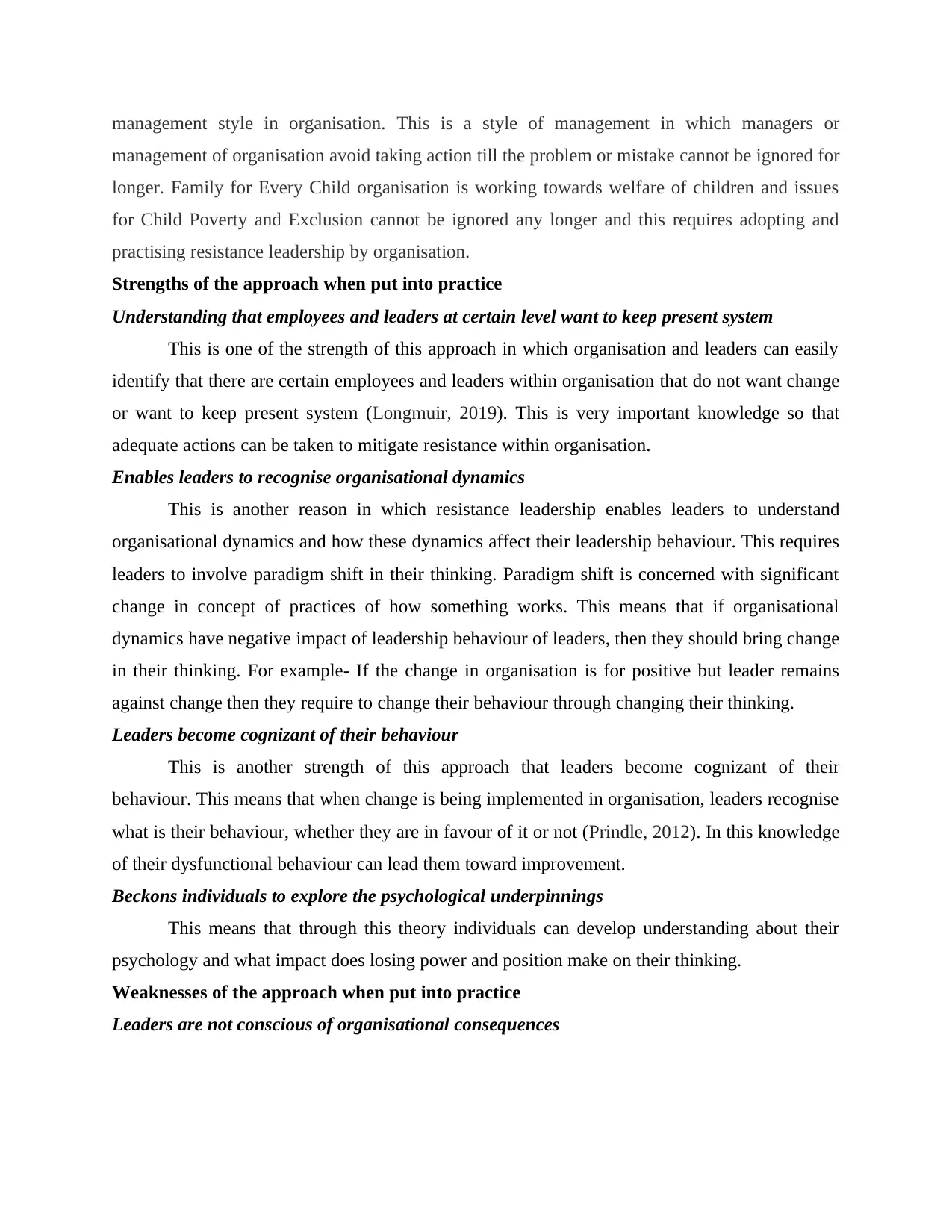
management style in organisation. This is a style of management in which managers or
management of organisation avoid taking action till the problem or mistake cannot be ignored for
longer. Family for Every Child organisation is working towards welfare of children and issues
for Child Poverty and Exclusion cannot be ignored any longer and this requires adopting and
practising resistance leadership by organisation.
Strengths of the approach when put into practice
Understanding that employees and leaders at certain level want to keep present system
This is one of the strength of this approach in which organisation and leaders can easily
identify that there are certain employees and leaders within organisation that do not want change
or want to keep present system (Longmuir, 2019). This is very important knowledge so that
adequate actions can be taken to mitigate resistance within organisation.
Enables leaders to recognise organisational dynamics
This is another reason in which resistance leadership enables leaders to understand
organisational dynamics and how these dynamics affect their leadership behaviour. This requires
leaders to involve paradigm shift in their thinking. Paradigm shift is concerned with significant
change in concept of practices of how something works. This means that if organisational
dynamics have negative impact of leadership behaviour of leaders, then they should bring change
in their thinking. For example- If the change in organisation is for positive but leader remains
against change then they require to change their behaviour through changing their thinking.
Leaders become cognizant of their behaviour
This is another strength of this approach that leaders become cognizant of their
behaviour. This means that when change is being implemented in organisation, leaders recognise
what is their behaviour, whether they are in favour of it or not (Prindle, 2012). In this knowledge
of their dysfunctional behaviour can lead them toward improvement.
Beckons individuals to explore the psychological underpinnings
This means that through this theory individuals can develop understanding about their
psychology and what impact does losing power and position make on their thinking.
Weaknesses of the approach when put into practice
Leaders are not conscious of organisational consequences
management of organisation avoid taking action till the problem or mistake cannot be ignored for
longer. Family for Every Child organisation is working towards welfare of children and issues
for Child Poverty and Exclusion cannot be ignored any longer and this requires adopting and
practising resistance leadership by organisation.
Strengths of the approach when put into practice
Understanding that employees and leaders at certain level want to keep present system
This is one of the strength of this approach in which organisation and leaders can easily
identify that there are certain employees and leaders within organisation that do not want change
or want to keep present system (Longmuir, 2019). This is very important knowledge so that
adequate actions can be taken to mitigate resistance within organisation.
Enables leaders to recognise organisational dynamics
This is another reason in which resistance leadership enables leaders to understand
organisational dynamics and how these dynamics affect their leadership behaviour. This requires
leaders to involve paradigm shift in their thinking. Paradigm shift is concerned with significant
change in concept of practices of how something works. This means that if organisational
dynamics have negative impact of leadership behaviour of leaders, then they should bring change
in their thinking. For example- If the change in organisation is for positive but leader remains
against change then they require to change their behaviour through changing their thinking.
Leaders become cognizant of their behaviour
This is another strength of this approach that leaders become cognizant of their
behaviour. This means that when change is being implemented in organisation, leaders recognise
what is their behaviour, whether they are in favour of it or not (Prindle, 2012). In this knowledge
of their dysfunctional behaviour can lead them toward improvement.
Beckons individuals to explore the psychological underpinnings
This means that through this theory individuals can develop understanding about their
psychology and what impact does losing power and position make on their thinking.
Weaknesses of the approach when put into practice
Leaders are not conscious of organisational consequences
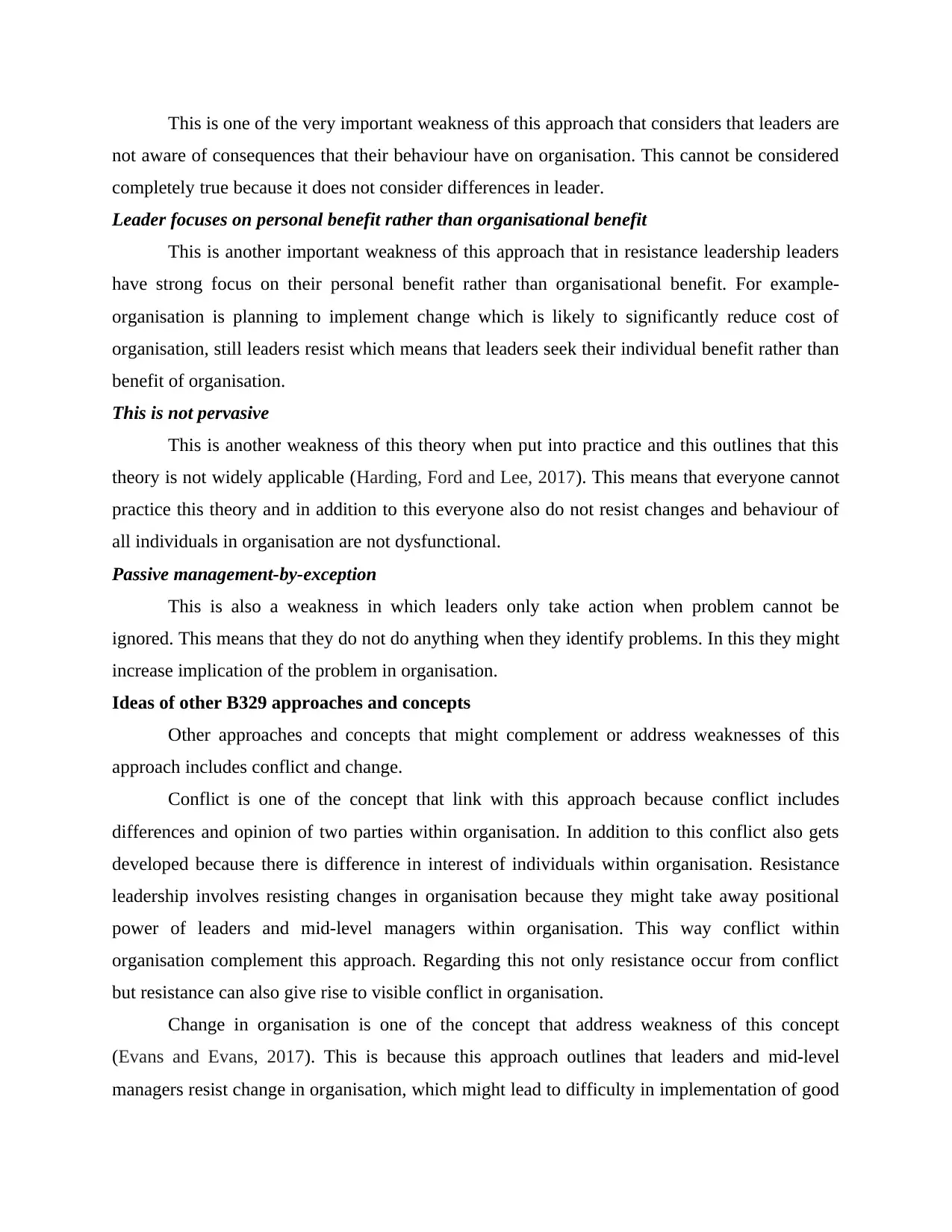
This is one of the very important weakness of this approach that considers that leaders are
not aware of consequences that their behaviour have on organisation. This cannot be considered
completely true because it does not consider differences in leader.
Leader focuses on personal benefit rather than organisational benefit
This is another important weakness of this approach that in resistance leadership leaders
have strong focus on their personal benefit rather than organisational benefit. For example-
organisation is planning to implement change which is likely to significantly reduce cost of
organisation, still leaders resist which means that leaders seek their individual benefit rather than
benefit of organisation.
This is not pervasive
This is another weakness of this theory when put into practice and this outlines that this
theory is not widely applicable (Harding, Ford and Lee, 2017). This means that everyone cannot
practice this theory and in addition to this everyone also do not resist changes and behaviour of
all individuals in organisation are not dysfunctional.
Passive management-by-exception
This is also a weakness in which leaders only take action when problem cannot be
ignored. This means that they do not do anything when they identify problems. In this they might
increase implication of the problem in organisation.
Ideas of other B329 approaches and concepts
Other approaches and concepts that might complement or address weaknesses of this
approach includes conflict and change.
Conflict is one of the concept that link with this approach because conflict includes
differences and opinion of two parties within organisation. In addition to this conflict also gets
developed because there is difference in interest of individuals within organisation. Resistance
leadership involves resisting changes in organisation because they might take away positional
power of leaders and mid-level managers within organisation. This way conflict within
organisation complement this approach. Regarding this not only resistance occur from conflict
but resistance can also give rise to visible conflict in organisation.
Change in organisation is one of the concept that address weakness of this concept
(Evans and Evans, 2017). This is because this approach outlines that leaders and mid-level
managers resist change in organisation, which might lead to difficulty in implementation of good
not aware of consequences that their behaviour have on organisation. This cannot be considered
completely true because it does not consider differences in leader.
Leader focuses on personal benefit rather than organisational benefit
This is another important weakness of this approach that in resistance leadership leaders
have strong focus on their personal benefit rather than organisational benefit. For example-
organisation is planning to implement change which is likely to significantly reduce cost of
organisation, still leaders resist which means that leaders seek their individual benefit rather than
benefit of organisation.
This is not pervasive
This is another weakness of this theory when put into practice and this outlines that this
theory is not widely applicable (Harding, Ford and Lee, 2017). This means that everyone cannot
practice this theory and in addition to this everyone also do not resist changes and behaviour of
all individuals in organisation are not dysfunctional.
Passive management-by-exception
This is also a weakness in which leaders only take action when problem cannot be
ignored. This means that they do not do anything when they identify problems. In this they might
increase implication of the problem in organisation.
Ideas of other B329 approaches and concepts
Other approaches and concepts that might complement or address weaknesses of this
approach includes conflict and change.
Conflict is one of the concept that link with this approach because conflict includes
differences and opinion of two parties within organisation. In addition to this conflict also gets
developed because there is difference in interest of individuals within organisation. Resistance
leadership involves resisting changes in organisation because they might take away positional
power of leaders and mid-level managers within organisation. This way conflict within
organisation complement this approach. Regarding this not only resistance occur from conflict
but resistance can also give rise to visible conflict in organisation.
Change in organisation is one of the concept that address weakness of this concept
(Evans and Evans, 2017). This is because this approach outlines that leaders and mid-level
managers resist change in organisation, which might lead to difficulty in implementation of good
Paraphrase This Document
Need a fresh take? Get an instant paraphrase of this document with our AI Paraphraser
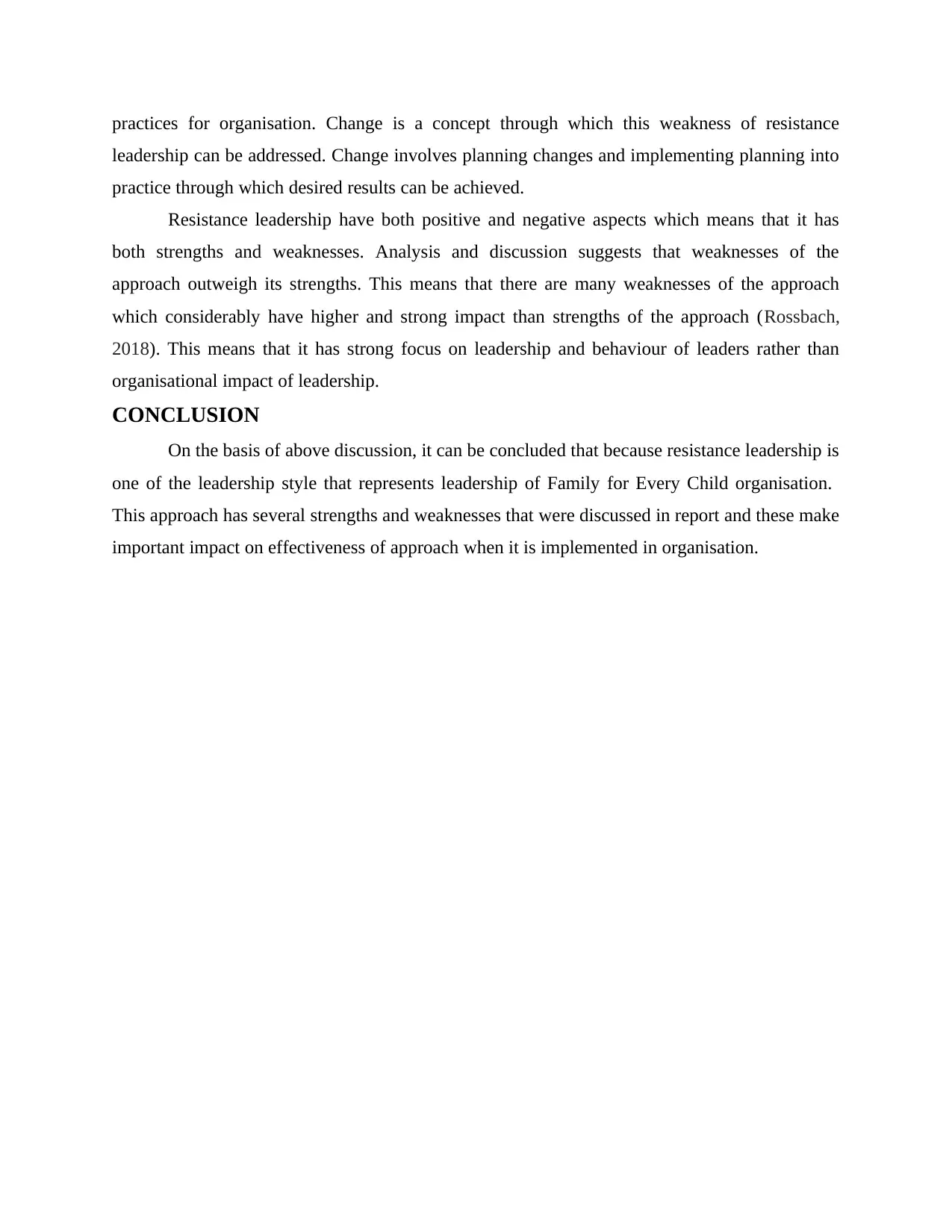
practices for organisation. Change is a concept through which this weakness of resistance
leadership can be addressed. Change involves planning changes and implementing planning into
practice through which desired results can be achieved.
Resistance leadership have both positive and negative aspects which means that it has
both strengths and weaknesses. Analysis and discussion suggests that weaknesses of the
approach outweigh its strengths. This means that there are many weaknesses of the approach
which considerably have higher and strong impact than strengths of the approach (Rossbach,
2018). This means that it has strong focus on leadership and behaviour of leaders rather than
organisational impact of leadership.
CONCLUSION
On the basis of above discussion, it can be concluded that because resistance leadership is
one of the leadership style that represents leadership of Family for Every Child organisation.
This approach has several strengths and weaknesses that were discussed in report and these make
important impact on effectiveness of approach when it is implemented in organisation.
leadership can be addressed. Change involves planning changes and implementing planning into
practice through which desired results can be achieved.
Resistance leadership have both positive and negative aspects which means that it has
both strengths and weaknesses. Analysis and discussion suggests that weaknesses of the
approach outweigh its strengths. This means that there are many weaknesses of the approach
which considerably have higher and strong impact than strengths of the approach (Rossbach,
2018). This means that it has strong focus on leadership and behaviour of leaders rather than
organisational impact of leadership.
CONCLUSION
On the basis of above discussion, it can be concluded that because resistance leadership is
one of the leadership style that represents leadership of Family for Every Child organisation.
This approach has several strengths and weaknesses that were discussed in report and these make
important impact on effectiveness of approach when it is implemented in organisation.
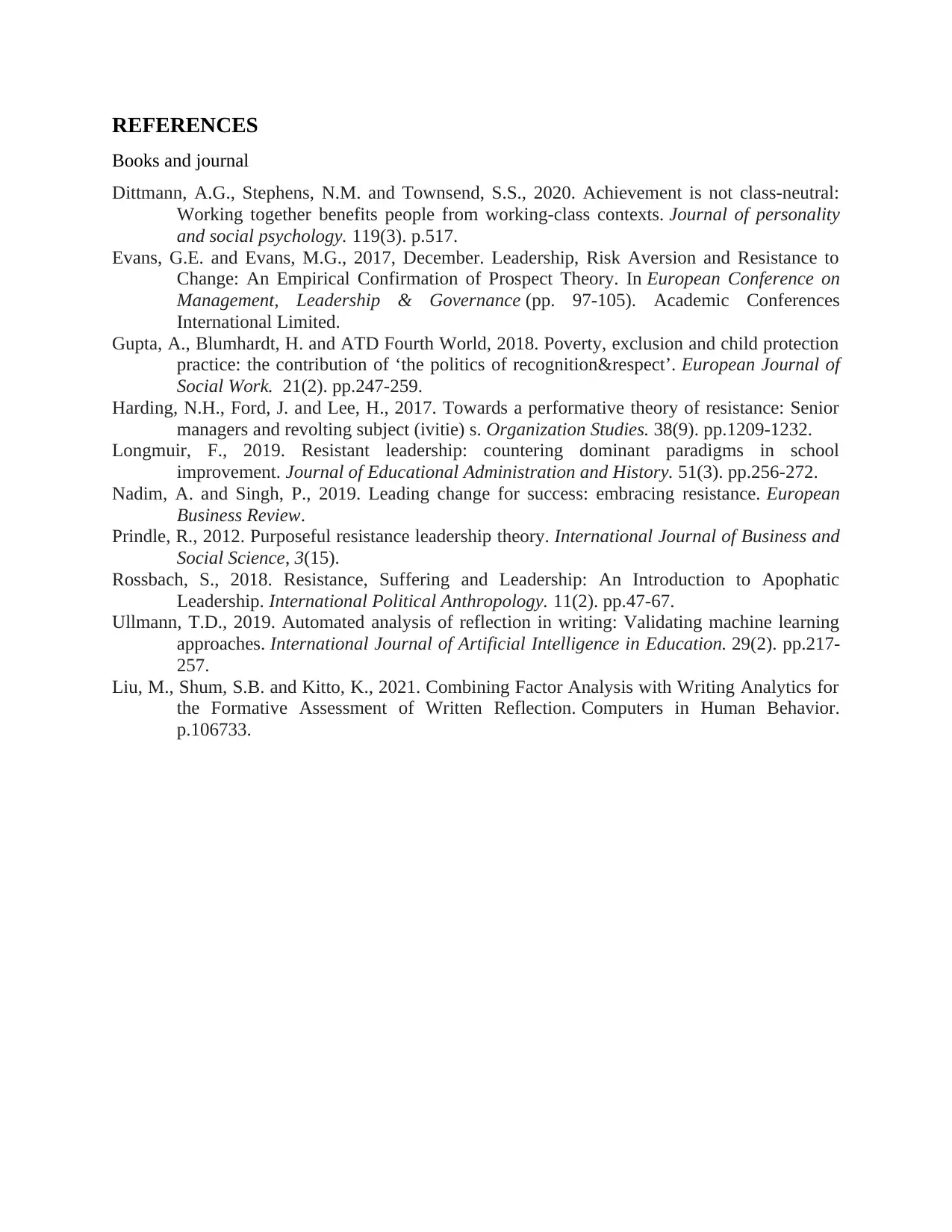
REFERENCES
Books and journal
Dittmann, A.G., Stephens, N.M. and Townsend, S.S., 2020. Achievement is not class-neutral:
Working together benefits people from working-class contexts. Journal of personality
and social psychology. 119(3). p.517.
Evans, G.E. and Evans, M.G., 2017, December. Leadership, Risk Aversion and Resistance to
Change: An Empirical Confirmation of Prospect Theory. In European Conference on
Management, Leadership & Governance (pp. 97-105). Academic Conferences
International Limited.
Gupta, A., Blumhardt, H. and ATD Fourth World, 2018. Poverty, exclusion and child protection
practice: the contribution of ‘the politics of recognition&respect’. European Journal of
Social Work. 21(2). pp.247-259.
Harding, N.H., Ford, J. and Lee, H., 2017. Towards a performative theory of resistance: Senior
managers and revolting subject (ivitie) s. Organization Studies. 38(9). pp.1209-1232.
Longmuir, F., 2019. Resistant leadership: countering dominant paradigms in school
improvement. Journal of Educational Administration and History. 51(3). pp.256-272.
Nadim, A. and Singh, P., 2019. Leading change for success: embracing resistance. European
Business Review.
Prindle, R., 2012. Purposeful resistance leadership theory. International Journal of Business and
Social Science, 3(15).
Rossbach, S., 2018. Resistance, Suffering and Leadership: An Introduction to Apophatic
Leadership. International Political Anthropology. 11(2). pp.47-67.
Ullmann, T.D., 2019. Automated analysis of reflection in writing: Validating machine learning
approaches. International Journal of Artificial Intelligence in Education. 29(2). pp.217-
257.
Liu, M., Shum, S.B. and Kitto, K., 2021. Combining Factor Analysis with Writing Analytics for
the Formative Assessment of Written Reflection. Computers in Human Behavior.
p.106733.
Books and journal
Dittmann, A.G., Stephens, N.M. and Townsend, S.S., 2020. Achievement is not class-neutral:
Working together benefits people from working-class contexts. Journal of personality
and social psychology. 119(3). p.517.
Evans, G.E. and Evans, M.G., 2017, December. Leadership, Risk Aversion and Resistance to
Change: An Empirical Confirmation of Prospect Theory. In European Conference on
Management, Leadership & Governance (pp. 97-105). Academic Conferences
International Limited.
Gupta, A., Blumhardt, H. and ATD Fourth World, 2018. Poverty, exclusion and child protection
practice: the contribution of ‘the politics of recognition&respect’. European Journal of
Social Work. 21(2). pp.247-259.
Harding, N.H., Ford, J. and Lee, H., 2017. Towards a performative theory of resistance: Senior
managers and revolting subject (ivitie) s. Organization Studies. 38(9). pp.1209-1232.
Longmuir, F., 2019. Resistant leadership: countering dominant paradigms in school
improvement. Journal of Educational Administration and History. 51(3). pp.256-272.
Nadim, A. and Singh, P., 2019. Leading change for success: embracing resistance. European
Business Review.
Prindle, R., 2012. Purposeful resistance leadership theory. International Journal of Business and
Social Science, 3(15).
Rossbach, S., 2018. Resistance, Suffering and Leadership: An Introduction to Apophatic
Leadership. International Political Anthropology. 11(2). pp.47-67.
Ullmann, T.D., 2019. Automated analysis of reflection in writing: Validating machine learning
approaches. International Journal of Artificial Intelligence in Education. 29(2). pp.217-
257.
Liu, M., Shum, S.B. and Kitto, K., 2021. Combining Factor Analysis with Writing Analytics for
the Formative Assessment of Written Reflection. Computers in Human Behavior.
p.106733.
1 out of 9
Related Documents
Your All-in-One AI-Powered Toolkit for Academic Success.
+13062052269
info@desklib.com
Available 24*7 on WhatsApp / Email
![[object Object]](/_next/static/media/star-bottom.7253800d.svg)
Unlock your academic potential
© 2024 | Zucol Services PVT LTD | All rights reserved.





